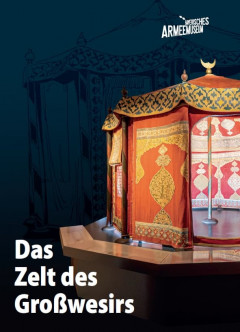The Tent of the Grand Vizier - in Ingolstadt
Daniel Hohrath, Ansgar Reiß, Priscilla Pfannmüller and Sarah M. Lorenz - the latter two members of the RIGG - have presented a richly illustrated study of a showpiece of the Bavarian Army Museum in Ingolstadt: the Grand Vizier's Tent - an Ottoman sleeping tent from the "Turkish Spoils" of Elector Max II. Emanuel from the year 1687.
The volume, published by Fink Verlag, is the collective responsibility of all four authors. The tent, which still presents itself today in an almost garish blaze of colour, has travelled for 350 years, which can be documented in numerous paintings and photographs. Passed around as a trophy for a long time, then shown as a curiosity at the "Wies'n" in Munich and finally exhibited in the tower of the New Palace, the tent is overflowing with history, which is spread out in four chapters:
- The Ottoman Tent in the Bavarian Army Museum
- Mobile Palaces - Tents in the Ottoman Empire
- Battle and Spoils (this is about the Battle of Mount Harsan on 12 August 1687)
- From trophy to exhibit
The tent of the Grand Vizier is thus "taken apart" by every trick in the book. Even the smallest trace in archival records and in pictorial documents is pursued. The book is of the highest scholarly standard and at the same time exciting and informative. Basically, it also contains a whole history of the museum - namely the development from the Wittelsbach Armoury to the Bavarian Army Museum. In addition, there is plenty of Ottoman cultural history on display - the fascination with the Orient still plays a role in such exhibits today.
The tent on display today is, of course, only one of an estimated 10,000 tents from the Turkish camp. It is also not the largest tent of the Grand Vizier's tent castle, but only a side tent: his sleeping tent and storage place for the war chest (p. 134, cf. p. 81). The main tent was also captured, but many pieces of loot rotted due to improper storage in the Munich armoury. Priscilla Pfannmüller is preparing another publication on this (p. 207 note 133).
- Details
- Written by: Stefan Heid
- Category: Recommended reading
 Römisches Institut der Görres-Gesellschaft
Römisches Institut der Görres-Gesellschaft







